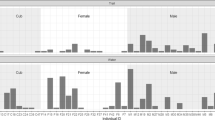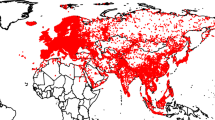Abstract
In an age of mass extinctions, confirming the survival of lost species provides rare second chances for biodiversity conservation. The silver-backed chevrotain Tragulus versicolor, a diminutive species of ungulate known only from Vietnam, has been lost to science for almost three decades. Here, we provide evidence that the silver-backed chevrotain still exists and the first photographs of the species in the wild, and urge immediate conservation actions to ensure its survival.
This is a preview of subscription content, access via your institution
Access options
Access Nature and 54 other Nature Portfolio journals
Get Nature+, our best-value online-access subscription
$29.99 / 30 days
cancel any time
Subscribe to this journal
Receive 12 digital issues and online access to articles
$119.00 per year
only $9.92 per issue
Buy this article
- Purchase on Springer Link
- Instant access to full article PDF
Prices may be subject to local taxes which are calculated during checkout


Similar content being viewed by others
Data availability
Owing to the high demand for wildlife products and the large-scale commercial hunting that is prevalent in Southeast Asia, we have decided with local conservation stakeholders not to release any detailed information on the newly confirmed population of silver-backed chevrotain. However, basic camera-trap record information (camera trap station number, date and time of photographs) is available from the corresponding author on reasonable request. Please note that we are unable to share the name of the survey site or exact GPS coordinates for the camera stations at this time.
References
Baltzer, M. C., Nguyen, T. D. & Shore, R. G. (eds) Towards a Vision for Biodiversity Conservation in the Forests of the Lower Mekong Ecoregion Complex: Summary of the Biological Assessment for the Ecoregion Biodiversity Conservation Program in the Forests of the Lower Mekong Ecoregion Complex (WWF, 2001).
Timmins, R. J., et al. Muntiacus vuquangensis. The IUCN Red List of Threatened Species 2016 e.T44703A22153828 (IUCN, 2016); https://doi.org/10.2305/IUCN.UK.2016-2.RLTS.T44703A22153828.en
Timmins, R. J., Hedges, S. & Robichaud, W. Pseudoryx nghetinhensis. The IUCN Red List of Threatened Species 2016 e.T18597A46364962 (IUCN, 2016); https://doi.org/10.2305/IUCN.UK.2016-2.RLTS.T18597A46364962.en
Tilker, A. et al. Saving the saola from extinction. Science 357, 1248 (2017).
Cochard, R., Ngo, D. T., Waeber, P. O. & Kull, C. A. Extent and causes of forest cover changes in Vietnam’s provinces 1993–2013: a review and analysis of official data. Environ. Rev. 25, 199–217 (2016).
Harrison, R. D. et al. Impacts of hunting on tropical forests in Southeast Asia. Conserv. Biol. 30, 972–981 (2016).
Nguyen, V. S. Wildlife trading in Vietnam: situation, causes, and solutions. J. Environ. Dev. 17, 145–165 (2008).
Gray, T. N. et al. Wildlife-snaring crisis in Asian forests. Science 355, 255–256 (2017).
Gray, T. N. et al. The wildlife snaring crisis: an insidious and pervasive threat to biodiversity in Southeast Asia. Biodivers. Conserv. 27, 1031–1037 (2018).
Redford, K. H. The empty forest. BioScience 42, 412–422 (1992).
Timmins, R. J., Duckworth, J. W. & Meijaard, E. Tragulus versicolor. The IUCN Red List of Threatened Species 2015 e.T136360A61978789 (IUCN, 2015); https://doi.org/10.2305/IUCN.UK.2015-2.RLTS.T136360A61978789.en
Thomas, O. Three new Asiatic mammals. Ann. Mag. Nat. Hist. 5, 534–536 (1910).
Kuznetsov, G. V. & Borissenko, A. V. A new record of Tragulus versicolor (Artiodactyla, Tragulidae) from Vietnam, and its sympatric occurrence with T. kanchil. Russ. J. Theriol. 3, 9–13 (2004).
Meijaard, E. & Groves, C. P. A taxonomic revision of the Tragulus mouse-deer (Artiodactyla). Zool. J. Linn. Soc. 140, 63–102 (2004).
Meijaard, E. & Groves, C. P. Recent study identifies the possible existence of a forgotten species. Oryx 38, 132–133 (2004).
Meijaard, E., Borissenko, A. V. & Kuznetsov, G. V. Rediscovery of Tragulus versicolor, the silver-backed chevrotain. Oryx 38, 254–255 (2004).
Tilker, A. et al. Nesolagus timminsi. The IUCN Red List of Threatened Species 2019 e.T41209A45181925 (IUCN, 2019).
Meijaard, E. & Nijman, V. Secrecy considerations for conserving Lazarus species. Biol. Conserv. 175, 21–24 (2014).
Ganas, J. & Lindsell, J. A. Photographic evidence of Jentink’s duiker in the Gola Forest Reserves, Sierra Leone. Afr. J. Ecol. 48, 566–568 (2010).
Sollmann, R., Linkie, M., Haidir, I. A. & Macdonald, D. W. Bringing clarity to the clouded leopard Neofelis diardi: first density estimates from Sumatra. Oryx 48, 536–539 (2014).
Tilker, A. et al. A little-known endemic caught in the South-east Asian extinction crisis: the Annamite striped rabbit Nesolagus timminsi. Oryx https://doi.org/10.1017/S0030605318000534 (2018).
Whitfield, J. A saola poses for the camera. Nature 396, 410 (1998).
Polet, G., Tran, V. M., Nguyen, X. D., Bui, H. M. & Baltzer, M. The Javan rhinos, Rhinoceros sondaicus annamiticus, of Cat Tien National Park, Vietnam: current status and management implications. Pachyderm 27, 34–47 (1999).
Schmid, M. Végétation du Viet-Nam: le massif sud-Annamitique et les régions limitrophes. Mémoires ORSTOM 74, 1–243 (1974).
Rundel, P. W. Forest Habitats and Flora in Lao PDR, Cambodia, and Vietnam (WWF, 1999).
Averyanov, L. V., Phan, K. L., Nguyen, T. H. & Harder, D. K. Phytogeographic review of Vietnam and adjacent areas of eastern Indochina. Komarovia 3, 1–83 (2003).
Gadgil, M., Berkes, F. & Folke, C. Indigenous knowledge for biodiversity conservation. Ambio 22, 151–156 (1993).
Newton, P., Nguyen, V. T., Roberton, S. & Bell, D. Pangolins in peril: using local hunters’ knowledge to conserve elusive species in Vietnam. Endanger. Species Res. 6, 41–53 (2008).
Zeller, K. A., Nijhawan, S., Salom-Pérez, R., Potosme, S. H. & Hines, J. E. Integrating occupancy modeling and interview data for corridor identification: a case study for jaguars in Nicaragua. Biol. Conserv. 144, 892–901 (2011).
Turvey, S. T. et al. Interview‐based sighting histories can inform regional conservation prioritization for highly threatened cryptic species. J. Appl. Ecol. 52, 422–433 (2015).
Timmins, R. J., Evans, T. D., Khounboline, K. & Sisomphone, C. Status and conservation of the giant muntjac Megamuntiacus vuquangensis, and notes on other muntjac species in Laos. Oryx 32, 59–67 (1998).
Abrams, J. F. et al. Studying Terrestrial Mammals in Tropical Rainforests. A User Guide for Camera-Trapping and Environmental DNA (Leibniz-IZW, 2018).
Niedballa, J., Sollmann, R., Courtiol, A. & Wilting, A. camtrapR: an R package for efficient camera trap data management. Methods Ecol. Evol. 7, 1457–1462 (2016).
Jarvis, A., Reuter, H. I., Nelson, A. & Guevara, E. Hole-filled SRTM data V4 (International Centre for Tropical Agriculture, 2008); http://srtm.csi.cgiar.org
Acknowledgements
We thank the team members, including T. A. D. Vo, T. Q. Le, N. T. Truong, H. H. P. Tran, V. T. Cao and local people for their support in the field; R. Timmins for discussions in survey planning; and W. Duckworth, R. Ratajszczak and R. Wirth for help with species identification. N. N. Spasskaya, Zoological Museum of Lomonosov, Moscow State University, provided access to the Gia Lai chevrotain specimen (S-151301). Funding for the surveys was provided by Wroclaw Zoo, Aukland Zoo, Mohamed bin Zayed Species Conservation Fund (Project 172515989), and the Gerald Singer Deer Research Grant provided by the Sainte Croix Biodiversité. We also thank Southern Institute of Ecology, Leibniz Institute for Zoo and Wildlife Research, Global Wildlife Conservation, and ARTIS Amsterdam Royal Zoo for additional support.
Author information
Authors and Affiliations
Contributions
A.N., T.A.M.N. and D.T.N. conducted the field work. A.N. and A.T. identified and processed camera-trap data. A.N. and A.T. wrote the first draft of the manuscript. A.W., V.B.T., D.M.H., T.A.M.N., D.T.N., T.V.T., E.M., J.H. and B.L. contributed to the manuscript and revised subsequent drafts.
Corresponding author
Ethics declarations
Competing interests
The authors declare no competing interests.
Additional information
Publisher’s note Springer Nature remains neutral with regard to jurisdictional claims in published maps and institutional affiliations.
Supplementary information
Rights and permissions
About this article
Cite this article
Nguyen, A., Tran, V.B., Hoang, D.M. et al. Camera-trap evidence that the silver-backed chevrotain Tragulus versicolor remains in the wild in Vietnam. Nat Ecol Evol 3, 1650–1654 (2019). https://doi.org/10.1038/s41559-019-1027-7
Received:
Accepted:
Published:
Issue Date:
DOI: https://doi.org/10.1038/s41559-019-1027-7
This article is cited by
-
Accurate population estimation of Caprinae using camera traps and distance sampling
Scientific Reports (2020)
-
Elusive deer-like animal ‘rediscovered’ in Vietnam
Nature (2019)



